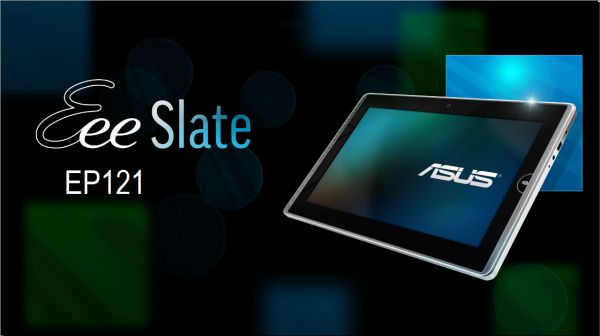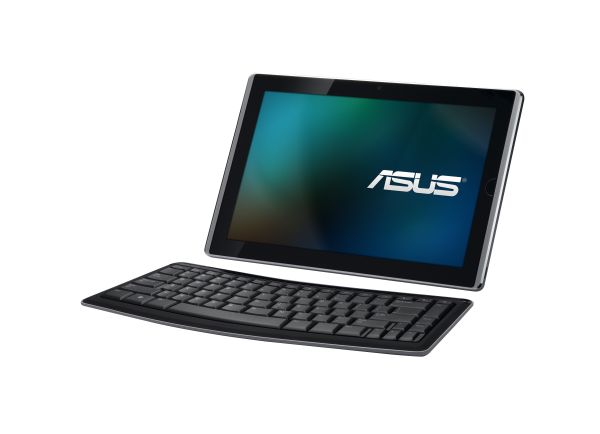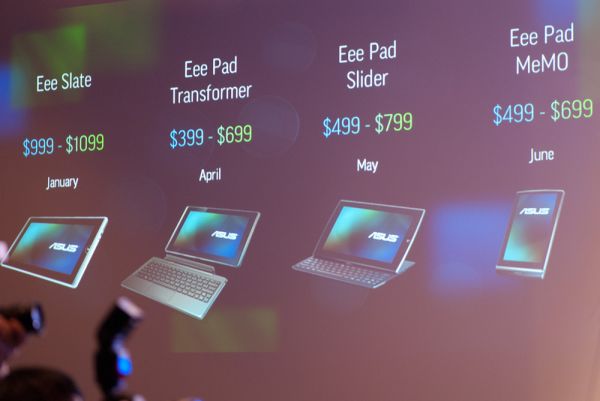ASUS Announces Eee Pad and Eee Slate Tablets
by Vivek Gowri on January 4, 2011 5:42 PM EST
And lastly, we have the Windows-based Eee Slate EP121 (I really don’t know where they come up with these names). There’s some history here, dating back to 2006 when ASUS first launched the R2h UMPC and R1F convertible tablet. They were ASUS’ first serious entry to the touchscreen PC market, and continued into the Eee PC T91 and T101 convertible netbooks. The Eee Pads and Eee Slate together will replace those.
The EP121 has Windows 7 Home Premium running on top of a Core i5-470UM, 2 or 4GB memory, and 32 or 64GB of flash storage. The 12.1” IPS panel has a 16:10 aspect ratio and WXGA resolution (1280x800), but most importantly features a Wacom active digitizer for pen-based handwriting recognition. The rest of the specs are pretty straightforward—a 2.0MP front facing camera, SDHC/SDXC card reader, one USB port, mini-HDMI, Bluetooth 3.0, and 2.4GHz 802.11n. A Bluetooth keyboard is included with the EP121; it looks to be a branded version of Microsoft’s Bluetooth Mobile Keyboard 6000.
In essence, the EP121 is a slate tablet PC with higher-end ultraportable internals. The combination of very respectable specs and the Wacom-enabled IPS display go a long way towards justifying the somewhat steep $999 cost, though given what HP is charging for its Atom-based 8.9” Slate ($799, to jog your memory), that figure looks almost reasonable. For $200 more, the ASUS has a lot more computing power and more features, though at 2.55lbs it’s a fair bit larger and heavier.
With that said, it’s still pretty thin and light, especially compared to some of the business-class convertible tablets on the market. I’m liking the overall package, since it balances power, portability, and price well along with the IPS display and Wacom digitizer. I think something that has gone mostly under the radar with the advent of tablets is the return of IPS displays in mobile computers—for a long time, IBM was the last one to offer IPS displays on their ThinkPad T series, but even they dumped the option in early 2007. Tablets are bringing IPS back, and that’s a very good thing.
The thing is, great specs or not, $999 is still a pretty hefty sum of money for a tablet, so I don’t forsee the EP121 making a huge sales dent. It’ll make a lot of sense for some users, like our smartphone editor Brian Klug, but it’s not really a tablet that can be recommended unless you want Windows and a Wacom digitizer. For a student looking for an ultraportable system, it looks like a very interesting option, and it’s definitely on the radar for inking fans, but at this point in time, I just don’t think that a Windows-based tablet solution is ideal for the majority of the tablet market. Either way, the Eee Slate should be available this quarter.
Wrap-Up
So that's the first CES salvo in what is sure to be a barrage of slate and tablet devices. ASUS is setting the standard with IPS displays across their lineup, which we'd love to see more of elsewhere. (Hint: we're tired of TN panel laptops!) The pricing looks reasonable, and the feature set is good as well. Perhaps the biggest drawback is that outside of the Slate, these are all targeting Q2/Q3 release dates, which means they're still a ways off from retail availability, but they might be worth the wait.













37 Comments
View All Comments
softdrinkviking - Thursday, January 6, 2011 - link
remind me, how was the battery life on that one?damianrobertjones - Wednesday, January 5, 2011 - link
I wouldn't really call the R2h a 'convertible tablet' and I should know as I have one sitting right next to me, with it's cray stylus that no longer likes to stay in it's slot and fan that never stops. Mmm, celeron.Why haven't I ever repalced it? Simple, it's great. Slow, huge, but does what it does. I might even get an SSD drive for it one day.
It also had gps! (Never worked very well, but its there)
ATOmega - Wednesday, January 5, 2011 - link
Not sure why tablet makers insist on gouging us so hard. Overall, the hardware costs them peanuts to produce. The majority of the OS is produced by google and all they're doing is integrating it. Most of the devices of which already have drivers.None of this is new to ASUS who have been in the business since forever. So why the premium? SOCs are supposed to reduce prices, not drive them up.
Do these use Gorilla Glass? Do they have GPS? Will I be able to buy one from somewhere other than a cell phone service provider? Will I be able to use the Android market? Are the prices in Canada going to have another $40 tacked on arbitrarily, even though our dollar is at par? How much extra will we pay just to get 1GB instead of 512MB?
I'm incredibly interested in the Transformer, but I'm not shelling out what will likely be $800 for a tablet and the keyboard! Get real! Offer a pack of the 1GB RAM model with the keyboard for $500. Overnight tablet market domination.
sjprg2 - Wednesday, January 5, 2011 - link
Why at this late date are they STILL putting USB 2 instead of USB 3 ports, and only 1 GB of memory? Same crap, with nothing moving ahead. No PCI-E ribbon for SSDs. Come on turkeys, Give us something to feel worthwhile spending our money on instead of rehashed crap. Still pushing SATA when PCIE is the logical step. Price is important, but performance is the bottom line for buying technology NOT toys.Paul
alfredska - Thursday, January 6, 2011 - link
Vivek Gowri's style of writing makes this article difficult to read right from the start. The first paragraph includes two sentences that start with "If you (are) ASUS...". The congratulatory statement to ASUS is probably best moved to end of the article and directed differently. These are quickly followed by an incomprehensible list that fails to properly join operating systems and hardware: "Three of them are Honeycomb-based tablets, joined by a traditional Windows slate. Looking at the Android tablets, we have the MeMO, a 7” Snapdragon slate, the Transformer, a 10” Tegra 2 slate with an optional keyboard docking station (hence the name), and the Slider, an interesting 10” model with a sliding, tilting keyboard (think a supersized HTC Touch Pro 2)." First, honeycomb should have been linked to Android for the bulk of the public who isn't familiar with all of the Android OS names. Second, list the devices concisely, then follow with descriptions. The processor names look as if they could be tablet names.I gave up reading beyond page one.
accolite - Friday, January 7, 2011 - link
Ive been looking for a slate with these kinds of specs for a while and the other is the Wacom pen, one question before I get too excited about this slate, is the pen pressure sensitive?If it is I am getting one as soon as it is coming out.
Anon51 - Sunday, March 20, 2011 - link
Let the buyer beware!I signed up just to say, as an owner of a Garmin-Asus A10 smartphone, it has come to my attention that every single LCD panel Asus uses in that phone has a significant amount of lazy pixels. After sending it back to Asus for repairs several times, every LCD panel they have replaced have come back equally flawed. Refunds are not available.
Suffice to say, i am extremely skeptical of their products, especially when they are priced well below market. Protect yourselves and do not purchase from this company unless you can be guaranteed a refund.
I pray you have a better experience with them than i did.